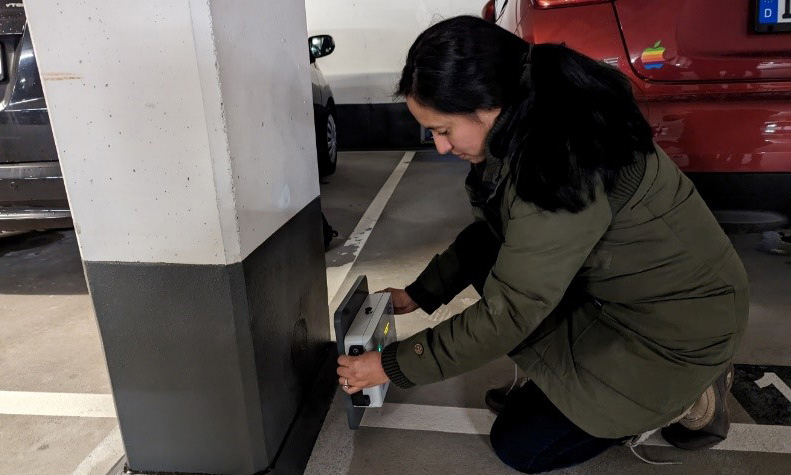
Revolutionizing Structural Health Monitoring: Wireless Embedded Sensor Technology for Long-Term Corrosion Detection and Prediction
In today’s rapidly evolving built environment, ensuring the safety, durability, sustainability, and resilience of our infrastructure is of utmost importance. One of the major challenges faced by structural and facilities engineers is the detection and prevention of corrosion-induced deterioration in reinforced concrete structures. Corrosion of reinforcing steel and post-tensioning (PT) in buildings and bridges can lead to costly repairs, reduced load ratings, shutdowns, and even collapse. Fortunately, advancements in wireless embedded sensor technology, combined with data transmission and collection in the cloud, data analysis, and the integration of AI, have opened up new avenues for continuous long-term structural health monitoring. In this article, we will explore the current state of the art in this field, highlighting the capabilities of wireless sensors, data collection, and analysis methodologies, and the role of AI in predicting future structural degradation.
Current State of the Art in Structural Health Monitoring
Traditionally, structural health monitoring relied on periodic visual inspections and manual measurements, which were time-consuming, limited in scope, and prone to human error. However, the advent of wireless embedded sensor technology has revolutionized the field. These sensors can be installed during construction or in rehabilitation and repair projects, enabling continuous monitoring of critical parameters such as temperature, humidity, strain, cracks, and corrosion. They provide continuous real-time data on the behavior of a structure, enabling engineers and owners to identify issues before they escalate into significant structural degradation. When caught early, potential issues can be corrected or mitigated. When corrosion is allowed to progress to a state that is detectable by visual inspection, the costs to repair the structure can be an order of magnitude greater. The figure indicates how repair costs increase exponentially with the progression of corrosion.
Wireless Data Transmission
Wireless sensor technology is available today that can be installed during original construction or during a repair or rehabilitation project. RFID enables wireless communication between the embedded sensors and the data reader (gateway). The sensors can be read remotely, eliminating the need for physical access to each sensor. Gateways can be permanently fixed to the structure, or they can be handheld devices used by the structural engineer during inspections. With fixed gateways, data collection is continuous and automated and does not rely on manual inspections. Embedded sensors require no batteries, so they will last over 80 years in the structure.



Data Collection in the IoT
The Internet of Things (IoT) plays a pivotal role in enabling seamless data collection from a vast network of wireless sensors. These sensors are interconnected and transmit their data to a central database via wireless networks. This centralized data collection allows for real-time monitoring and analysis, empowering structural engineers to make informed decisions promptly. The IoT infrastructure also facilitates data aggregation, ensuring a comprehensive overview of the structural health across multiple locations and time frames.
Data Analysis
The enormous amount of data collected from wireless sensors necessitates advanced data analysis techniques. Data analysis algorithms, such as machine learning and statistical modeling, can identify patterns and correlations within the sensor data. By employing anomaly detection algorithms, engineers can pinpoint structural hotspots where corrosion is occurring. Additionally, data analysis can provide valuable insights into the environmental conditions that contribute to corrosion such as moisture intrusion, aiding in the development of targeted preventive measures.
Using AI to Predict Future Structural Degradation
Artificial intelligence (AI) algorithms can analyze historical sensor data, environmental factors, and other relevant parameters to predict future structural degradation. By training AI models on a vast dataset of structural health information, the system can learn patterns and indicators that precede corrosion-related issues. AI-powered predictive analytics can alert engineers to potential problems well in advance, enabling proactive maintenance and cost-effective interventions.
CorroDec2G by InfrastructureTek
One notable product in the field of wireless embedded sensor technology is CorroDec 2G, by Infrastructure Tek in partnership with Infrasolute. CorroDec 2G is an advanced wireless sensor system specifically designed for continuous monitoring of corrosion in reinforced concrete structures. It provides real-time corrosion detection (not corrosion potential), allowing engineers to assess the rate and severity of corrosion accurately. The system’s compatibility with RFID technology ensures seamless data transmission, collection, and analysis. Furthermore, the long lifespan of CorroDec 2G sensors, lasting over 70 years within a structure, ensures long-term monitoring capabilities, saving costs for the structure’s owner and contributing to a safer and more durable structure over its lifetime.
Wireless embedded sensor technology, combined with RFID data transmission, IoT data collection, data analysis, and AI-powered predictive analytics, has transformed the field of structural health monitoring. This technology enables continuous, long-term monitoring of buildings susceptible to corrosion-induced deterioration, whether in new construction or rehabilitation projects. By employing products like CorroDec 2G by Infrastructure Tek, structural engineers can proactively manage corrosion-related risks, save costs on repairs, and ensure the safety and longevity of structures for years to come.
Groundbreaking advancements in wireless embedded sensor technology, IoT data transmission, analysis, and AI-powered predictive analytics, have transformed the way we monitor and ensure the integrity of new and existing structures like never before.
Corrosion-and-humidity-induced deterioration in reinforced concrete structures poses significant challenges, but continuous monitoring using wireless sensors can detect and prevent issues before they escalate. The IoT facilitates seamless data collection and analysis, empowering us to make informed decisions promptly. AI algorithms analyze historical data to predict future structural degradation. Products like CorroDec 2G by InfrastructureTek offer advanced wireless sensor systems for accurate corrosion detection and long-term monitoring. This technology ensures safer and more durable structures while saving costs on repairs.